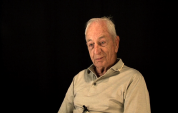7:01 | Although Les Carter’s Airborne soldiers were paratroopers, they never used parachutes in Vietnam, relying on helicopters to deploy and fight. As in modern conflicts, booby traps were the main source of casualties.
Keywords : Les Carter Vietnam civilian District Chief booby trap Iraq Afghanistan monofilament trip wire chopper helicopter parachute

Les Carter was among the first military advisors to Vietnam, assigned to Pleiku in the fifties to help the Vietnamese develop a curriculum for their military academy.
When Les Carter arrived in Vietnam during the Tet Offensive, his battalion’s District was very unstable. By the time he left, nearly all enemies had been killed or driven off. That was the assessment of a North Vietnamese commander.
Working closely with local forces was the key to Les Carter’s success in stabilizing his District in Vietnam. He received a Silver Star for one action, but he wonders why that particular one.
Les Carter knew his district was secure when he recovered a letter from a North Vietnamese commander lamenting defeat. He also knew it came at a cost to civilians, such as the group of young nurses who walked into an ambush.
When Les Carter traveled by helicopter to the action in Vietnam, he often had the local Vietnamese District Chief along. A doctor or a chaplain also might be on board, along with the crew of four.
Growing up in a military family, Les Carter considered going to West Point to be his duty. His first assignment took him to Austria as part of the Cold War deterrent.